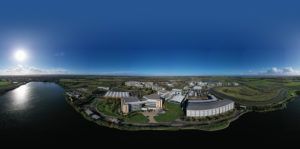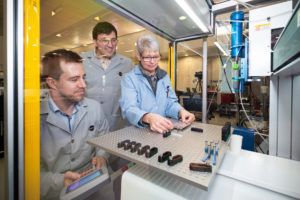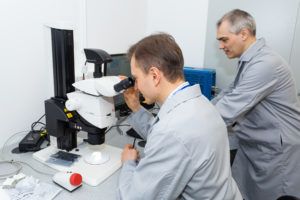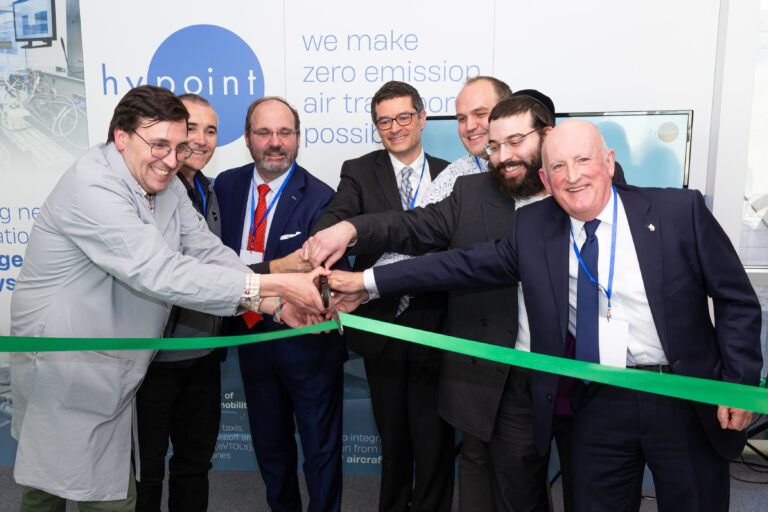Hypoint has opened an R&D and production site in the UK to make its air-cooled hydrogen fuel cells, which are being developed specifically for use in aircraft.
The laboratories in Sandwich, Kent were officially inaugurated last month. Speaking at the opening ceremony Alex Ivanenko, HyPoint’s founder and CEO said, “The launch of the manufacturing site is an important step in our journey.
“Our work here is critical to unlocking faster decarbonization of aviation and urban air mobility, whilst also creating economic activity and jobs across the country to support the long-term sustainability of the UK’s aviation industry.”

Hypoint, which has headquarters in Menlo Park, California and was founded in 2019 has 600 fuel cell systems on order through agreements with firms including hydrogen aircraft developer ZeroAvia and US rotorcraft manufacturer Piasecki Aircraft.
Hypoint is working with Piasecki on the PA-890 compound eVTOL helicopter. The PA-890 is set to become the first hydrogen-powered manned helicopter when it is launched in 2025.
Jon Piasecki said, “We are enjoying working with Hypoint on what we believe is a revolutionary product in vertical flight that will help democratize aviation.
“The biggest challenge is cost. This technology could reduce that by 50%. That is a transformational amount.”
“ZeroAvia is doing most of its R&D activity for our 10-20 seat aircraft in the UK and it’s great to have a leading fuel cell developer such as HyPoint nearby,” said Val Miftakhov, founder and CEO of ZeroAvia, who was also present at the ceremony.
“We will continue to work closely with HyPoint to develop hydrogen fuel cells for our future power plants and are looking forward to even closer collaboration going forward.”
Hypoint aims to have its fuel cell certified for commercial use by the end of 2025 at which time the Sandwich, UK facility will employ 100 people and be capable of making 100MW of fuel cells a year, enough to supply around 200 aircraft, rising to 1000MW by 2028.

The company plans to invest more than £11 million (US$14.4 million) in the Sandwich facility over the next three years. “Engineering and R&D are the most important activities for our company,” said Ivanenko. “The fuel cells will be produced, tested and certified in the Sandwich facility.”
High temperature benefits
The high-temperature proton-exchange membrane (HTPEM) fuel cell system uses bipolar plates made from an aluminium foil that is light, commercially viable and has a high thermal conductivity. The system uses compressed air for cooling during flight and as a source of oxygen supply.
According to Hypoint, testing conducted in April 2021 showed that its fuel cell can provide 2,000W/kg of specific power, more than triple the power-to-weight ratio and 60% lighter than conventional liquid-cooled hydrogen fuel cells systems. Its fuel cells have an energy density of 1,500Wh/kg, more than seven times the energy density of current battery systems.
“We have figured out how to increase temperature and pressure in the cell without increasing weight. We are two to three years ahead of the competition. There’s no solution like it on the market,” said Ivanenko. “The main weight savings are possible because there is no liquid cooling. There is also no moisture control, which makes the system simpler.”
Hypoint is partnering with German chemicals company BASF to develop and manufacture the membrane electrode assembly (MEA) that the fuel cell system uses. Engineers are working to further increase the durability of the fuel cell and on a new design that utilizes a new geometry and manufacturing technologies this year.
Carsten Henschel, senior sales manager energy at BASF said, “We started working with Hypoint two years ago. At first I was sceptical, but they convinced me with test results and a design that is a paradigm shift for the technology. I have been working with fuel cells for more than 20 years and they have opened our eyes up to the possibilities and triggered innovation.”
With cyclic operation, impurities in the gas flow and changing environmental conditions can stress the materials used in low-temperature fuel cells. HTPEM fuel cells operate at temperatures of between 120-180°C (248-356˚F), enabling a high tolerance to impurities and simplifying temperature and water management.
Bespoke testing

Over the next two years engineers at Hypoint’s Sandwich facility will test single cells and stacks at high power levels in its ATEX approved laboratories. The testing laboratory has a high ceiling of about 10m (33ft) to stop explosive gas accumulating and extensive ventilation.
A bespoke rig has been developed to test the fuel cells. The rig, which looks like a model wind tunnel, puts stacks under temperatures of up to 180˚C (356˚F) at a number of different pressures.
Sergey Panov, co-founder and chief technical officer of Hypoint said, “The test rig is for single fuel cells and short stacks up to 120kW. It is able to simulate the conditions the fuel cell will be subjected to during a real flight in an aircraft.”





